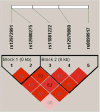Association of genetic variants with rapid fibrosis: progression after liver transplantation for hepatitis C
- PMID: 24770613
- PMCID: PMC4524502
- DOI: 10.1097/01.TP.0000440953.06886.a3
Association of genetic variants with rapid fibrosis: progression after liver transplantation for hepatitis C
Abstract
Background: Recurrence of hepatitis C, the main indication for liver transplantation in the United States, leads to rapid fibrosis progression and worse outcomes compared to other indications. While clinical variables play a role, they are insufficient to explain all inter-patient variability in posttransplant fibrosis progression. Genetic factors associated with hepatitis C virus (HCV) outcomes have been identified, but limited studies have been conducted in the context of HCV-related liver transplantation. Therefore, the purpose of this study was to examine candidate genes related to the immune response and rate of fibrosis in subjects undergoing liver transplantation for HCV.
Methods: One hundred twelve recipients with detailed posttransplant fibrosis and clinical information were genotyped using 25 single nucleotide variants (SNVs), including five SNVs within the IL28B gene region. Associations between SNVs and rapid fibrosis progression were performed controlling for pertinent clinical variables and haplotype analyses for the IL28B gene were completed.
Results: Significant multivariable associations were found for rs8099917 (IL28B), rs1991401 (DDX5), rs4969168 (SOC3), and rs7976497 (MLEC). The minor allele was protective against rapid fibrosis progression for the IL28B SNV (G allele), MLEC SNV (T allele), and DDX5 SNV (G allele). For the SOC3 SNV, the minor allele (A) increased the risk for rapid fibrosis progression. Additionally, two recipient haplotype structures for IL28B were significantly associated with rapid fibrosis progression.
Conclusions: These findings indicate that recipient genetic factors play a role in posttransplant HCV-related fibrosis progression. Molecular studies of these pathways may elucidate the pathogenesis of posttransplant fibrosis progression and provide risk prediction markers.
Conflict of interest statement
The authors declare no conflicts of interest.
Figures


Similar articles
-
IL28B alleles associated with poor hepatitis C virus (HCV) clearance protect against inflammation and fibrosis in patients infected with non-1 HCV genotypes.Hepatology. 2012 Feb;55(2):384-94. doi: 10.1002/hep.24678. Epub 2011 Dec 16. Hepatology. 2012. PMID: 22180014
-
Impact of EGF, IL28B, and PNPLA3 polymorphisms on the outcome of allograft hepatitis C: a multicenter study.Clin Transplant. 2016 Apr;30(4):452-60. doi: 10.1111/ctr.12710. Epub 2016 Mar 1. Clin Transplant. 2016. PMID: 26854475 Free PMC article.
-
Impact of Il28b-related single nucleotide polymorphisms on liver transient elastography in chronic hepatitis C infection.PLoS One. 2013 Nov 14;8(11):e80172. doi: 10.1371/journal.pone.0080172. eCollection 2013. PLoS One. 2013. PMID: 24244641 Free PMC article.
-
Genetic variation in the interleukin-28B gene is not associated with fibrosis progression in patients with chronic hepatitis C and known date of infection.Hepatology. 2011 Oct;54(4):1127-34. doi: 10.1002/hep.24503. Epub 2011 Aug 19. Hepatology. 2011. PMID: 21721028
-
Interleukin-28B and fibrosing cholestatic hepatitis in posttransplant hepatitis C: a case-control study and literature review.Liver Transpl. 2013 Dec;19(12):1311-7. doi: 10.1002/lt.23733. Liver Transpl. 2013. PMID: 24039107 Review.
Cited by
-
Association of IFNL3 and IFNL4 polymorphisms with liver-related mortality in a multiracial cohort of HIV/HCV-coinfected women.J Viral Hepat. 2015 Dec;22(12):1055-60. doi: 10.1111/jvh.12431. Epub 2015 Jun 26. J Viral Hepat. 2015. PMID: 26115445 Free PMC article.
-
Suppressor of Cytokine Signaling-3 Gene Polymorphisms and the Risk of Hepatocellular Carcinoma in Chronic Hepatitis C Patients in Egypt.Asian Pac J Cancer Prev. 2023 Dec 1;24(12):4253-4261. doi: 10.31557/APJCP.2023.24.12.4253. Asian Pac J Cancer Prev. 2023. PMID: 38156861 Free PMC article.
References
-
- Charlton M. Hepatitis C infection in liver transplantation. Am J Transplant. 2001;1:197. - PubMed
-
- Forman LM, Lewis JD, Berlin JA, et al. The association between hepatitis C infection and survival after orthotopic liver transplantation. Gastroenterology. 2002;122:889. - PubMed
-
- Testa G, Crippin JS, Netto GJ, et al. Liver transplantation for hepatitis C: recurrence and disease progression in 300 patients. Liver Transpl. 2000;6:553. - PubMed
-
- Berenguer M, Prieto M, Rayón JM, et al. Natural history of clinically compensated hepatitis C virus-related graft cirrhosis after liver transplantation. Hepatology. 2000;32(4 Pt 1):852. - PubMed
-
- Berenguer M, Crippin J, Gish R, et al. A model to predict severe HCV-related disease following liver transplantation. Hepatology. 2003;38:34. - PubMed
Publication types
MeSH terms
Substances
Grants and funding
LinkOut - more resources
Full Text Sources
Other Literature Sources
Medical

